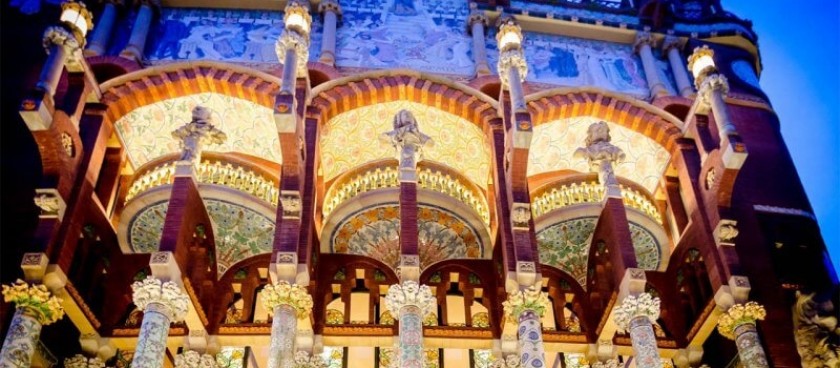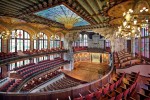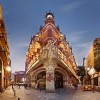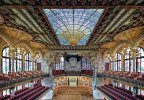- #ES9
- C/ Palau de la Música, 4-6, 08003 Barcelona, Spain
- +34932957200
- publics@palaumusica.cat
- https://www.palaumusica.cat/en
- Working hours*:
Open to the public all year round. Opening hours depend on the season:
September - June: 09:30 to 15:30;
July - August: 09:30 to 18:00. - Prices*:
Adult - from 20 €;
Preliminary (if purchased 21 days before the expected date) - 16 €;
Seniors over 65 years old - 16 €;
Students and unemployed - 11 €;
Children under 10 years old accompanied by adults - free of charge. - * - opening and closing times as well as entrance prices, are subject to alterations without notice. Visitors are advised to check before visiting.
- 41.3875752, 2.1752913 Copy to clipboard Copy
-
#Family time , #Museums
The Palace of Catalan Music, located in Sant Pere, Barcelona's old quarter, is one of the city's most visited attractions. Grand architecture, in which curved lines prevail over curves, and dynamic forms over static, attracts even those who, in principle, do not consider themselves to be music lovers. Even though the construction of Palau, which the locals called the magic music box, lasted only 3.5 years, he became the best example of Catalan Art Nouveau.
Palau de la Musica Catalana, located near the famous Gothic Quarter, can be called one of the main symbols of the Catalan capital. The concert hall, one of Barcelona's most popular music halls, regularly hosts operettas, musicals, chamber, jazz, symphony and folk concerts, and other musical events. In addition, stars of popular Spanish music often perform on the Palau stage, and until some time, such world celebrities as Montserrat Caballe, Svyatoslav Richter and Mstislav Rostropovich shone.
The "magic music box", which annually receives up to 500 thousand visitors, is the only European concert venue in Europe with exclusively natural light. In 1997, this luxurious building, which played a massive role in the cultural development of its country, was included in the UNESCO heritage list.
Historical reference
The history of the Palace of Catalan Music in Barcelona began on February 9, 1908. Initially, it served as a concert hall and as the headquarters for the Catalan Orpheon, a local choral society created to popularize authentic Catalan music in northeastern Spain. The implementation of the plan, approved in May 1904, required colossal material costs. Only for purchasing a land plot, the total area was 1350 sq. m., more than 11 thousand euros spent! However, the city treasury hardly suffered from this because it almost carried out all construction and finishing work with the money of numerous Catalan patrons of art.
The project manager was Lewis Domenech y Montaner, a famous Spanish politician and architect who awarded the gold medal to construct the best urban building after completing all the work. From 1982 to 1989, the Palau building, declared a national monument of the country, was repeatedly expanded and reconstructed. In the early 2000s, significant restoration of the theatre also carried out.
Thanks to the respectful attitude of the local authorities towards this building, Palau de la Musica Catalana continues to arouse genuine interest and remain one of the most famous attractions in Barcelona. Due to its vast size, due to the presence of a metal frame, it hosts concert performances and various conferences, exhibitions, and other public events related to Spain's cultural and political life.
Architecture and interior decoration
Looking at the photos of the Palace of Catalan Music in Barcelona, it is impossible not to notice the graceful balconies, columns with intricate capitals, carved decorative patterns and other elements characteristic of Art Nouveau. Among other things, in the facade's design, motives of Eastern and Spanish architecture are traced, represented by multi-coloured glazed tiles and intricate candelabra, over which busts of famous world composers - Bach, Wagner, Beethoven, Palestrina, etc. installed.
Especially from all this diversity stands out "Catalan Folk Song", a small sculptural group created by one of the best monumentalism in Spain. The upper lobe of the façade, decorated with a symbolic image of the local choral society and the old theatre box office, hidden inside a massive column and decorated with beautiful mosaic ornaments, are no less delightful. Inside, the Palau building looks just gorgeous. Spacious halls, decorated with wrought iron railings, coloured stained-glass windows and exquisite stucco mouldings, attract the enthusiastic glances of visitors and make them completely forget about the time.
The largest hall of the Palau de la Musica Catalana is the main concert hall, designed for 2.2 thousand spectators and is a real work of art. The ceiling of this site, made in a vast inverted dome, is covered with pieces of colourful glass mosaic. At the same time, pastel and amber shades prevail in their central part, and blue and blue on the periphery. This combination of colours was not chosen by chance - in good weather (and therefore high-quality lighting), they look like the sun and heavenly heights. The concert hall walls also consist almost entirely of stained-glass windows, which gives the impression that everything around is moving in some direction only known to him.
Among all this luxury, you can see many statues made by outstanding sculptors of the last century, images of 18 muses of Ancient Greece and a sculptural composition based on the plot of "Valkyrie", the world-famous opera by Richard Wagner. The central place in the hall occupied by the organ, over which the national flag of Catalonia flies.






